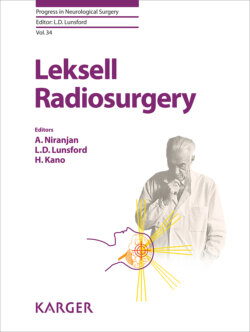Читать книгу Leksell Radiosurgery - Группа авторов - Страница 94
На сайте Литреса книга снята с продажи.
Quality Assurance
ОглавлениеQuality assurance (QA) for Gamma Knife units consists of a series of tests performed frequently or infrequently. Frequent tests for QA are designed to be fast, efficient, and simple checks to verify the proper functionality of the equipment. The FOCUS precision test [23, 24] (Fig. 5) and the CBCT precision test are two examples of frequent QA. The FOCUS precision test verifies that the PPS is aligned correctly to the RFP by scanning the diode through the radiation shot of a 4-mm collimator. The couch will scan through each coordinate axis twice to ensure that the direction of travel of the PPS is linear. There are 12 points used to determine the displacement of the PPS to the Leksell stereotactic coordinate position of 100, 100, 100 in x, y, and z. For imaging QA, the CBCT precision test is a relative test that determines the coordinates in Leksell stereotactic space of 4 steel BBs. The BBs on the imagining detector can be ray traced back into Leksell stereotactic space and compared to the initial commissioning values. The testing tolerance is <0.5 mm. Additional daily QA checks cover: if the room radiation monitor is operational, audio-visual functionality, immobilization micro-switches, couch functionality and patient protection, emergency test, and timer termination of exposure. Infrequent tests are designed to thoroughly review major components and ensure that major changes have not taken place. Frame check QA determines if the frame is square by placing it on a metal plate with 4 pins precisely square to match the standard frame. The frame is then placed on top of the metal plate, if it fits then the frame is square, if not the frame is bent and should be removed from the clinic. An image-guided phantom CatPhan Model 503 (Phantom Laboratory Inc., Salem, NY, USA) provided by Elekta is imaged with the two modes available. Elekta recommends three tests to be performed on this phantom [18]: line pair resolution, Hounsfield unit uniformity, and the contrast to noise ratio (CNR). These tests are outlined within the Elekta user’s manual [25]. Examples of monthly QA checks are: all activities of the daily QA, absolute dose rate determination, clearance tool Flextip test, emergency battery backups of the main controller, battery backup of the office supply, and verification of the treatment planning software. The annual requirements for Gamma Knife units include the daily and monthly tests, but a further three additional tests are performed: the RFP determination, sector uniformity, and the cavity leakage. The initial loading of the Gamma Knife unit consists of 192 sources of approximate equal loading, <1% variation in the source strength per the supplier of the 60Co sources. This loading is verified by closing all sectors and keeping one sector open and measuring the total charge accumulated. Using the ABS or solid water phantom with an ionization chamber placed at the RFP one can measure the charge collected from one sector open versus the other ones closed. This is completed for each sector and the sector uniformity is calculated, with tolerance <3%. The cavity leakage test determines how much exposure an individual receives to the whole body with the treatment doors open and the sources retracted. With an ABS or solid water phantom and an ionization chamber, the charge can be collected with all sectors closed at the RFP and then all sectors open. The cavity leakage should be <0.5%.
Fig. 5. The FOCUS precision tool (below) with diode exposed (above). This figure is of the ICON version that has the 4 BBs used for the CBCT precision test. Courtesy of Elekta.
